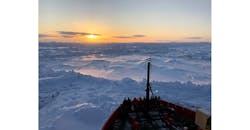Research in Arctic and Antarctic waters typically require navigating through ice-filled seas. But the U.S. Naval Research Laboratory (NRL,) is finding that its Global Ocean Forecast System (GOFS) can provide invaluable information about the polar regions, even to ships sent to break up the ice. Recently, the GOFS helped an ice-breaking research ship navigate safely out of ice-filled waters.
The ship in this instance was the research vessel Nathaniel B. Palmer, performing extended scientific research in the Antarctic Ocean as part of the U.S. Antarctic Program. During research in March, the ship could not maneuver around large ice blocks while traveling through Pine Island Bay in quest of open waters. The GOFS, first developed in 2013, is designed to assimilate data from several sources and calculate/predict current masses and concentrations of sea ice as well as areas of converging or diverging ice. By analyzing data on diverging ice masses, for example, a ship can be provided with a possible path for navigation to open waters.
The captain of the Nathaniel B. Palmer, John-Martin Souza, points to the seven-day forecast provided by the GOFS as the information that was instrumental in finding his way out of ice-congested waters. “With the right imagery and extra support products GOFS provided, I was able to find a way out in only one day, after the previous four days of trying,” said Souza. “Everyone on our ship is grateful for the up-to-date information about the ice conditions.”
U.S. Naval Research Laboratory, www.nrl.navy.mil
About the Author
Jack Browne
Technical Contributor
Jack Browne, Technical Contributor, has worked in technical publishing for over 30 years. He managed the content and production of three technical journals while at the American Institute of Physics, including Medical Physics and the Journal of Vacuum Science & Technology. He has been a Publisher and Editor for Penton Media, started the firm’s Wireless Symposium & Exhibition trade show in 1993, and currently serves as Technical Contributor for that company's Microwaves & RF magazine. Browne, who holds a BS in Mathematics from City College of New York and BA degrees in English and Philosophy from Fordham University, is a member of the IEEE.
